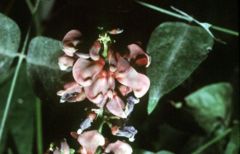Apios americana
| Apios americana subsp. var. | ||||||||||||||||||||||||||||||||||||||||||||||||||||||||
|---|---|---|---|---|---|---|---|---|---|---|---|---|---|---|---|---|---|---|---|---|---|---|---|---|---|---|---|---|---|---|---|---|---|---|---|---|---|---|---|---|---|---|---|---|---|---|---|---|---|---|---|---|---|---|---|---|

|
|
| ||||||||||||||||||||||||||||||||||||||||||||||||||||||
| ||||||||||||||||||||||||||||||||||||||||||||||||||||||||
| Standard Cyclopedia of Horticulture |
|---|
|
Apios tuberosa, Moench. Groundnut. Wild Bean. Fig. 233. Four to 8 ft., climbing over bushes: root bearing strings of edible tubers, 1-2 in. long: lfts. 5-7, ovate-lanceolate: fls fragrant, chocolate-brown, the standard very broad and turned back, the keel long, incurved and scythe-shaped. July, Aug.—Common in low grounds and swamps. The fr. often fails to mature. Prop, by the tubers. 2-4 of which should be planted together at a depth of 3-4 in.; also, by seeds. Grows well in the wild border, in any loose, rich soil. Under these conditions, the plant covers a trellis or other support in a comparatively short time. Dry tubers offered by seedsmen are likely to start slowly. The brown of the fls. is a very unusual color in hardy herbs. Likely to become a weed in rockeries and wild gardens.
|
| Apios americana {{{status}}} Fossil range: {{{fossil_range}}}
| ||||||||||||||||||||||||||||||||||||||||||||||||||||||||||||||||||
|---|---|---|---|---|---|---|---|---|---|---|---|---|---|---|---|---|---|---|---|---|---|---|---|---|---|---|---|---|---|---|---|---|---|---|---|---|---|---|---|---|---|---|---|---|---|---|---|---|---|---|---|---|---|---|---|---|---|---|---|---|---|---|---|---|---|---|
 | ||||||||||||||||||||||||||||||||||||||||||||||||||||||||||||||||||
| Plant Info | ||||||||||||||||||||||||||||||||||||||||||||||||||||||||||||||||||
| ||||||||||||||||||||||||||||||||||||||||||||||||||||||||||||||||||
| Scientific classification | ||||||||||||||||||||||||||||||||||||||||||||||||||||||||||||||||||
| ||||||||||||||||||||||||||||||||||||||||||||||||||||||||||||||||||
| [[{{{diversity_link}}}|Diversity]] | ||||||||||||||||||||||||||||||||||||||||||||||||||||||||||||||||||
| {{{diversity}}} | ||||||||||||||||||||||||||||||||||||||||||||||||||||||||||||||||||
| Binomial name | ||||||||||||||||||||||||||||||||||||||||||||||||||||||||||||||||||
| Apios americana Medikus | ||||||||||||||||||||||||||||||||||||||||||||||||||||||||||||||||||
| Trinomial name | ||||||||||||||||||||||||||||||||||||||||||||||||||||||||||||||||||
| {{{trinomial}}} | ||||||||||||||||||||||||||||||||||||||||||||||||||||||||||||||||||
| Type Species | ||||||||||||||||||||||||||||||||||||||||||||||||||||||||||||||||||
| {{{type_species}}} | ||||||||||||||||||||||||||||||||||||||||||||||||||||||||||||||||||
| {{{subdivision_ranks}}} | ||||||||||||||||||||||||||||||||||||||||||||||||||||||||||||||||||
| [[Image:{{{range_map}}}|{{{range_map_width}}}|]] | ||||||||||||||||||||||||||||||||||||||||||||||||||||||||||||||||||
| Synonyms | ||||||||||||||||||||||||||||||||||||||||||||||||||||||||||||||||||
| A. tuberosa Moench |
Apios americana, sometimes called the hog peanut, potato bean, or groundnut (but not to be confused with other plants sometimes known by the name groundnut) is a perennial vine native to eastern North America, and bears edible beans and large edible tubers. It grows to 3-4 m long, with pinnate leaves 8-15 cm long with 5-7 leaflets. The flowers are red-brown to purple, produced in dense racemes. The fruit is a legume (pod) 6-12 cm long.
The tubers are crunchy and nutritious, with a high content of starch and especially protein. The plant was one of the most important food plants of pre-European North America, and is now being developed for domestication.